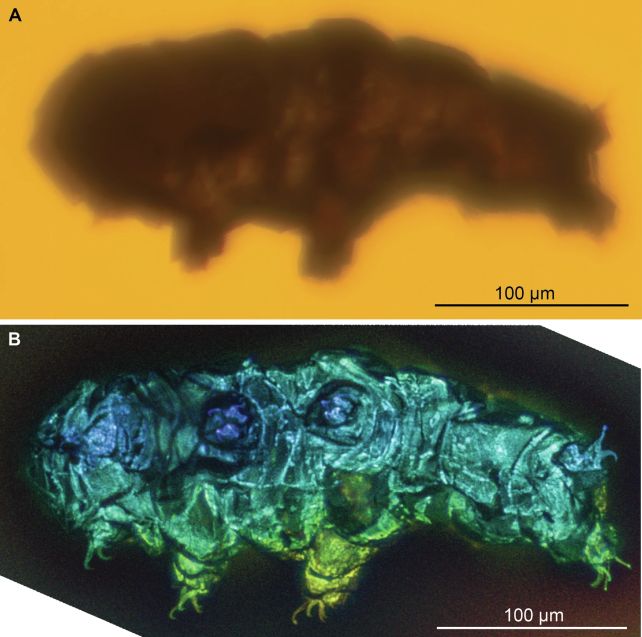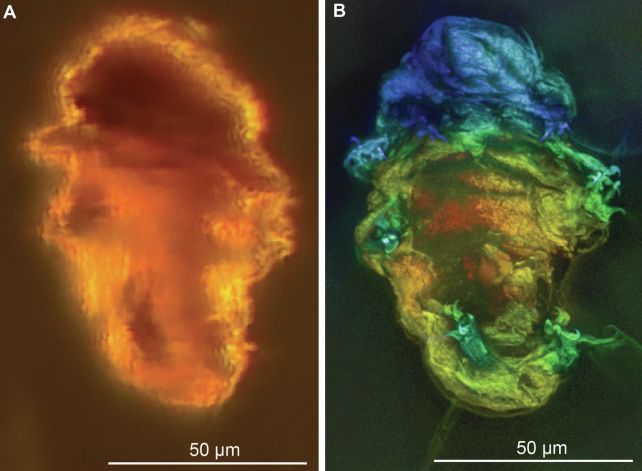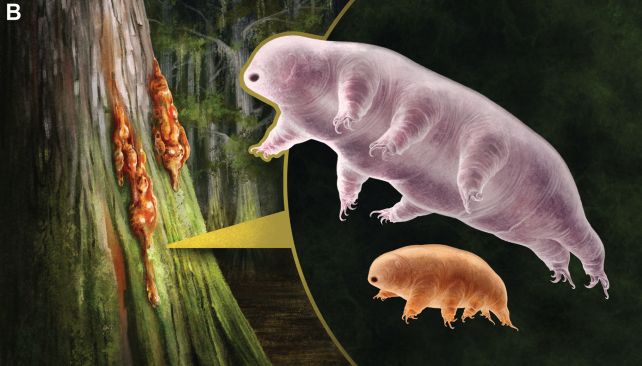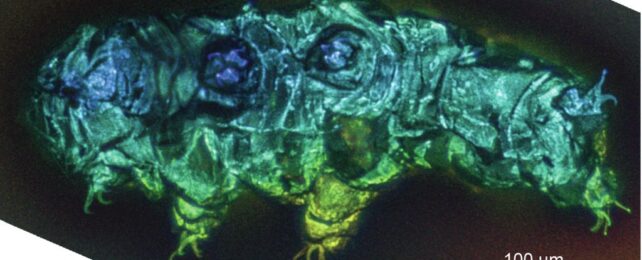Tardigrades, the microscopic little eight-legged beasties that are thought to be among the toughest organisms on the planet, have been around a long time. According to their molecular clock, these adaptable creatures first emerged before the Cambrian, some 541 million years ago, and they've been making their wiggly way through the world ever since.
Today, tardigrades can be found living pretty much anywhere on Earth you look. From the frozen tundra, to the arid desert, to the bottom of the ocean, tardigrades have found a way to survive and thrive. But for all their success and ubiquity, the fossil record contains very few specimens.
That's not a surprise. They are very small, and relatively squishy; when they die, they break down quickly, their bodies not conducive to the rigors of fossilization. But there are, nevertheless, a few ancient tardigrades that have been preserved for millions of years, thanks to the magic of amber.
Humans have recovered just four tardigrade specimens that became trapped in oozy, stick tree resin that hardened into amber, dating back nearly 150 million years. These are highly prized: they can shed some light on tardigrade evolution and, perhaps, their absolutely epic survival skills.

However, creatures in amber can be hard to study, and it has been difficult to place the specimens in neat spaces in the tardigrade family tree. Amber can be dark and cloudy, and tardigrades are really small. Three of the tardigrades in amber had been studied and named, but the fourth remained elusive, too small to make out in detail.
That challenge has now been surmounted by a team of zoologists led by Marc Mapalo of Harvard University. They have used a technique called confocal fluorescence microscopy that uses a pinhole to obtain far more detailed images of microscopic subjects than can be obtained using widefield microscopy.
The researchers have studied two tardigrade specimens that are embedded in the same piece of Canadian amber, dated back to the Cretaceous, between 72 and 83 million years ago, during the last age of non-avian dinosaurs. And, well, you can see the results of the confocal microscopy technique for yourself: they were able to obtain much more detailed images of the two tardigrades than previous attempts.
The first tardigrade is known as Beorn leggi, and it was named and described decades ago, in 1964. By conducting more in-depth imaging of B. leggi, the researchers were able to discern physical characteristics that eluded previous studies, including the shape of its little claws, and the lack of protuberances on its wrinkly little body.

And, for the first time, we have seen in detail the second tardigrade in the amber, once thought too small and too poorly preserved to make out much detail. This tiny little speck has now been given a formal name, Aerobius dactylus, and assigned its own twig on the large and complicated family tree.
Like B. leggi, A. dactylus is barrel-shaped and without protuberances, with idiosyncratic claws on the ends of its eight legs. The claws of both species are similar to each other, as well as to those of a superfamily of tardigrades called Hypsibioidea. In all three, the claws curving towards the body are shorter than those curving away from it, suggesting both species belong to this group.
B. leggi and A. dactylus are long extinct, but other Hypsibioidea species are alive today. B. leggi and A. dactylus are finally reunited with their tardigrade people.
Interestingly, though, the claws of A. dactylus are significantly longer on its rearmost pair of legs. That pair of claws resembles those of a tardigrade genus called Isohypsibius. And this curious trait has been observed in other tardigrade species alive today, suggesting that the fourth pair of tardigrade legs can have a different evolutionary history than the three other pairs of legs on the same tardigrade.
The analysis also allowed the researchers to arrive at some conclusions about the evolutionary history of tardigrades. There are two main lineages: heterotardigrades, which often live in the ocean, and mostly freshwater eutardigrades.
Although both B. leggi and A. dactylus are eutardigrades, their age suggests that the lineages diverged around 500 million years ago, which is a little later than scientists had thought.

And, by comparing the two fossils with modern tardigrades, the researchers were able to figure out a timeline for when the tardigrade superpower emerged: cryptobiosis, the ability to almost completely dry out and enter suspended animation for indefinite periods of time. This ability emerged 180 million years ago at the latest, and may date back as far as 420 million years.
This is a timeframe that covers several of Earth's mass extinctions, and may provide clues as to the amazing longevity of these remarkable animals.
"The acquisition of cryptobiotic abilities of these tardigrades around this time could be one of the factors that have helped them evade extinction," the researchers write.
Their findings have been published in Communications Biology.
